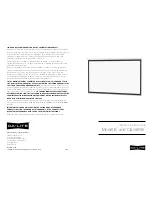
15
Fig. 5
Pull up zipper without unnecessary force, a section
at a time, stretching the zipper with one hand while
slowly pulling up the fastener with the other hand.
Pull fastener toggle only in a plane with the suit sur-
face. Pull toggle as flat as possible.
Attention!
Never force the two zipper halves together through
stronger pulling. A forcible closing may permanently
damage the zipper which could cause it to break
open during use.
Don compressed air breathing apparatus according
to Instruction for Use.
4.3
Removing the Protective Suit
If the suit is heavily soiled, a preliminary cleaning
should be done while it is still on the man. This is
done with water and, if necessary, with detergent
additives. Care must be taken that any assistant is
wearing proper personal protective equipment, e. g.,
protective gloves, respiratory protection, protective
clothing.
When removing the protective suit, avoid contact
with the soiled outside of the suit
4.4
Disposal of Contaminated Suits
Depending on the chemicals they were exposed to,
contaminated suits must be disposed observing ex-
isting legislation regarding toxic waste.
5
Care and Maintenance
5.1 Cleaning
The protective suit must be cleaned after each use.
To do this, remove the valve discs of the suit, the in-
halation and exhalation valve disc of the facepiece
and unbutton the inner mask and remove the
speaking diaphragm, using the key (see Ordering
Information). These parts must be cleaned sepa-
rately and are fitted back only after they have been
dried.
If the suit is not too badly soiled, it is washed once in
water at +30 °C to which a smooth detergent has
been added. If it is badly soiled the procedure is re-
peated. Following this it is rinsed twice in clear water.
In case other detergents or processes are to be
used, their suitability must be confirmed by the de-
tergent manufacturer.
Afterwards the opened suit is hung up by the boots.
The protective suit and the removed parts must not
be dried in radiant heat (sun-light, radiator). When
using a drying cabinet the temperature must not ex-
ceed +40 °C. After the protective suit has been
cleaned, the zipper must be cleaned separately with
water and a brush or paintbrush removing all foreign
objects like bristles, hairs, threads etc. Never scratch
clean with hard or sharp objects.
5.2
Disinfection
After cleaning, the suit should be disinfected using
e. g.
»
AUER 90
«
disinfectant (see Ordering Infor-
mation).
Observe the Instructions for Use of the disinfectant.
5.3 Maintenance
After each use or cleaning and regularly every six
months a pressure/tightness test of the suit, the
mask and the suit valves must be made using the
MSA AUER suit test kit and mask test kit The zipper
must be lubricated with a grease pencil or zipper
spray after each cleaning or after half a year’s stor-
age and must be moved afterwards.
5.4
Tightness Test of the Protective Suit
Tightness test of built-in mask is to be done with the
MSA AUER mask test kit :
•
Create a negative pressure of 10 mbar
•
Maximum permissible pressure rise in 1 min must
not exceed 1 mbar
To inflate the protective suit, use only compressed
air that is clean and free from oil.
•
Inflate suit to 16 mbar.
•
Stabilizing time 3 min.
•
Reduce pressure to 18 mbar (test pressure).
•
Maximum permissible pressure drop in 3 min is
2 mbar.
At the end of the test, reassemble the valve discs
and valve covers.
Valve tightness test see section 6.1.
Note:
In order to avoid erroneous readings, the test
should be conducted in a room free of draft.
Содержание VAUTEX ELITE 3SL Type 1b ET EN 943-2
Страница 1: ...MSA AUER Vautex Elite SL...


































